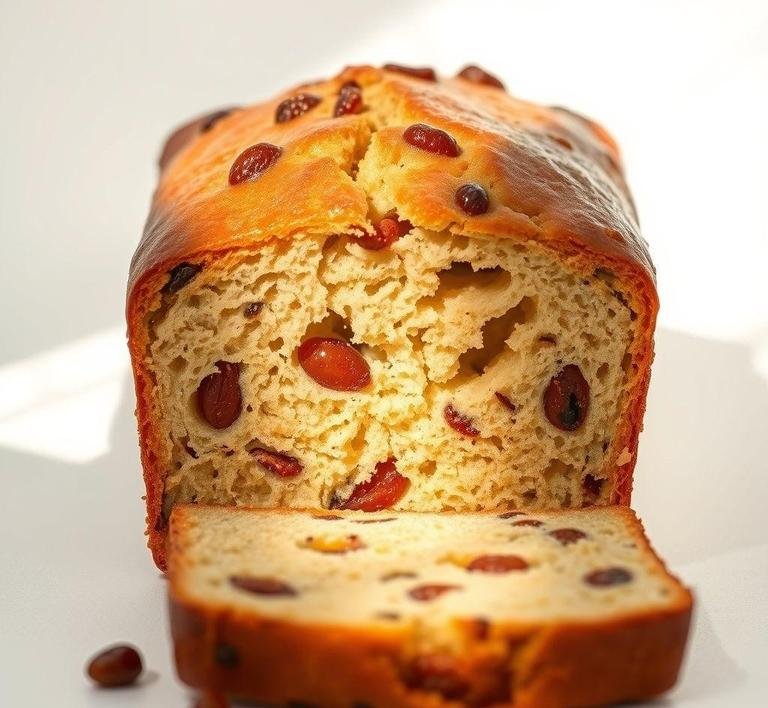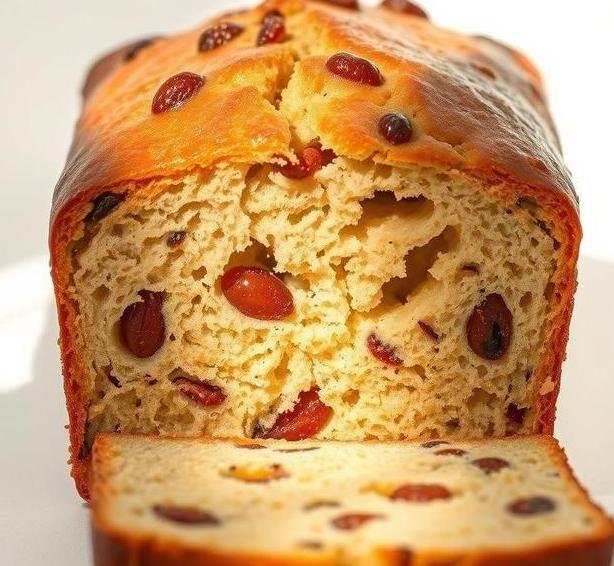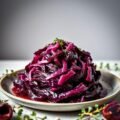Mary Berry’s Sultana Tea Loaf is a quintessentially British baked delight, deeply rooted in the comforting tradition of teatime treats. This loaf is a moist, gently spiced cake, studded generously with sultanas-those plump, golden raisins that add a burst of natural sweetness and chewiness in every bite. It’s a simple yet elegant cake that has stood the test of time, thanks largely to Mary Berry’s meticulous recipes that balance flavor, texture, and ease of preparation perfectly.
The tea loaf is often enjoyed sliced thin and spread with a generous pat of butter, allowing the richness of the bread to complement the juicy sultanas and the subtle warm spices that Mary typically incorporates. Unlike heavier fruitcakes packed with candied fruits and nuts, the Sultana Tea Loaf feels lighter, making it ideal for afternoon tea, brunch, or even a comforting snack with a cup of tea or coffee.
What truly makes Mary Berry’s version special is her approach to soaking the sultanas in strong tea before baking. This technique infuses the dried fruit with a rich depth of flavor and extra moisture, resulting in a tender crumb and a wonderfully fragrant loaf that smells as good as it tastes. It’s a perfect harmony of old-fashioned charm and culinary precision, the hallmark of Mary Berry’s baking philosophy.
Mary Berry’s Sultana Tea Loaf Recipe
Ingredients Needed

To recreate Mary Berry’s Sultana Tea Loaf at home, you’ll want to gather a list of simple, accessible ingredients that combine to create its signature taste and texture:
- Sultanas: About 200 grams (7 oz). These are the stars of the loaf. You want plump, juicy sultanas that soak up the tea beautifully.
- Strong black tea: Approximately 300 ml (1¼ cups). This is used to soak the sultanas, infusing them with a deep, rich flavor.
- Self-raising flour: 225 grams (8 oz). This helps the loaf rise nicely without needing extra baking powder.
- Soft brown sugar: 175 grams (6 oz). Adds a gentle caramel sweetness and moisture.
- Butter: 75 grams (3 oz), softened. This enriches the batter and keeps the loaf tender.
- Eggs: 2 large eggs, beaten. These bind the ingredients together and give the loaf structure.
- Mixed spice or ground cinnamon: 1 teaspoon. This adds warmth and subtle spice notes that complement the fruit.
- Baking powder: 1 teaspoon (sometimes optional if using self-raising flour, but often added for extra lift).
- Salt: A pinch to balance sweetness and enhance flavor.
These ingredients create a balance of moistness, sweetness, and gentle spice, which is what makes the tea loaf so comforting and flavorful.
Equipment Needed
Though Mary Berry’s Sultana Tea Loaf is a simple recipe, having the right equipment can make the baking process smoother and ensure the loaf bakes evenly:
- Loaf tin: A standard 2-pound (9×5 inch) loaf tin works perfectly. It shapes the loaf and ensures even baking.
- Mixing bowls: At least one large mixing bowl to combine your ingredients comfortably.
- Measuring scales or cups/spoons: Accurate measurements are key for baking success.
- Whisk or wooden spoon: For mixing the batter smoothly.
- Sieve: To sift the flour and spices, avoiding lumps and creating a light texture.
- Cooling rack: Essential to cool the loaf evenly and prevent sogginess on the bottom.
- Teapot or kettle: To brew strong black tea for soaking the sultanas.
- Cling film or a lid: To cover the soaked sultanas as they infuse.
While these are fairly basic kitchen items, having them ready will make your baking experience enjoyable and less stressful.
Instructions To Make Mary Berry’s Sultana Tea Loaf
Let’s walk through the process step by step. This will give you a clear, confident approach to baking this wonderful loaf.
-
Soak the sultanas
Begin by brewing strong black tea-about 300 ml (just over a cup). Pour this over the sultanas in a bowl and cover with cling film or a lid. Let them soak for at least 1 hour, or even overnight if you have time. This soaking is the secret to a moist, flavorful loaf.
-
Preheat the oven and prepare the tin
Set your oven to 160°C (320°F) fan oven or 180°C (350°F) conventional. Grease your loaf tin thoroughly with butter or line it with parchment paper to prevent sticking.
-
Mix dry ingredients
In a large mixing bowl, sift together the self-raising flour, mixed spice, baking powder, and a pinch of salt. This ensures an even distribution of leavening agents and spices.
-
Cream butter and sugar
In another bowl, cream the softened butter and soft brown sugar together until light and fluffy. This step incorporates air, helping the loaf rise.
-
Add eggs
Gradually beat in the eggs, a little at a time, making sure the mixture doesn’t curdle. If it starts to separate, add a spoonful of flour to stabilize.
-
Combine wet and dry
Fold the soaked sultanas (along with any leftover tea) into the flour mixture, then gently combine with the creamed butter and sugar mixture. Use a spatula or wooden spoon to mix just until combined; overmixing can make the loaf tough.
-
Bake
Pour the batter into the prepared tin, smoothing the top. Bake for approximately 60-70 minutes. The loaf should be golden brown and a skewer inserted in the center should come out clean.
-
Cool
Remove the loaf from the oven and let it cool in the tin for about 10 minutes. Then transfer to a cooling rack to cool completely before slicing.
Tips And Tricks
- Soaking time is everything: The longer you soak your sultanas, the more flavorful and moist your loaf will be. If possible, soak overnight.
- Use strong tea: Earl Grey or Assam tea works beautifully. Avoid weak tea, or the flavor will be diluted.
- Room temperature ingredients: Ensure your butter and eggs are at room temperature for better mixing and texture.
- Don’t overmix: Folding the batter gently preserves the light crumb.
- Check oven temperature: Every oven is different, so start checking your loaf after about 50 minutes. If it’s browning too quickly, tent with foil.
- Serve with butter or cream cheese: The loaf is delicious sliced thin and spread with softened butter or a tangy cream cheese for a little extra indulgence.
- Storage: Keep the loaf wrapped tightly in foil or airtight container. It can last up to a week or freeze well for up to 3 months.
Mary Berry’s Sultana Tea Loaf is more than just a simple cake; it’s a nostalgic, comforting companion to any teatime or snack occasion. Its moist texture, infused with the subtle warmth of spices and the sweet tang of tea-soaked sultanas, offers a perfect balance of flavors that feels both timeless and effortlessly elegant. Whether you’re an experienced baker or a beginner, this recipe invites you into a world of traditional British baking with an approachable, reliable method.
Baking this loaf yourself is a rewarding experience-every step, from soaking the fruit to smelling the sweet aroma wafting through your kitchen, connects you to a heritage of simple pleasures. So, put on your apron, brew that strong tea, and enjoy the heartwarming ritual of making and sharing Mary Berry’s Sultana Tea Loaf. It’s a slice of cozy tradition that’s truly hard to resist.
Easy Recipe Variations For Mary Berry’s Sultana Tea Loaf

Mary Berry’s Sultana Tea Loaf is a classic, comforting treat-a moist, lightly spiced bread studded with sweet sultanas that’s perfect for teatime or any time really. But what if you want to put your own spin on this beloved recipe? The beauty of the tea loaf is its versatility, and you can easily tweak it to suit your taste or what you have in your pantry.
1. Fruit Variations:
While sultanas are traditional, you can experiment with other dried fruits to give your loaf a different flavor and texture. Try substituting or mixing sultanas with currants, chopped dates, or dried cranberries for a tart pop of flavor. For a more tropical twist, chopped dried apricots, mango, or even finely diced dried pineapple can add an exotic flair. For the ultimate indulgence, throw in some chopped glacé cherries or candied peel to boost the sweetness and festive look.
2. Nutty Additions:
For added crunch and richness, toss in some toasted nuts. Walnuts, pecans, or almonds pair beautifully with the warm spices and fruit. Roughly chop them before folding into the batter so every slice gets a satisfying texture contrast.
3. Spices and Flavors:
The typical tea loaf is gently spiced with cinnamon and mixed spice, but you could customize this. Add a pinch of ground ginger or nutmeg for warmth. For a slightly more unusual twist, try cardamom or even a splash of orange blossom water or rosewater to impart a subtle floral note.
4. Alcohol Infusions:
A splash of sherry, brandy, or dark rum soaked into the dried fruit before mixing them into the batter adds a luxurious depth of flavor. Soak the sultanas overnight for best results, and you’ll find the loaf tastes decadently rich and moist.
5. Wholemeal or Gluten-Free Options:
For a healthier take, substitute half the plain flour for wholemeal flour or spelt flour for nuttier, earthier notes. If gluten is a concern, a gluten-free flour blend can be used, though you might need to adjust the liquid slightly to get the perfect batter consistency.
6. Citrus Zest:
A little lemon or orange zest grated into the batter can brighten up the loaf’s flavor wonderfully. This adds freshness and a zing that cuts through the sweetness of the dried fruit.
By playing around with these variations, you can keep Mary Berry’s timeless recipe feeling fresh and exciting every time you bake it!
Storing Leftovers
One of the best things about Mary Berry’s Sultana Tea Loaf is how well it keeps, making it a perfect make-ahead treat or something to nibble on over several days.
Short-Term Storage:
Wrap your cooled tea loaf tightly in cling film or store it in an airtight container at room temperature. This helps keep the moisture locked in, preserving its soft texture. Under these conditions, it will stay fresh for up to 4 days. Avoid refrigerating as this can dry out the loaf, making it less enjoyable.
Long-Term Storage:
If you want to keep the tea loaf longer, freezing is your best option. Slice the loaf first-this way, you can thaw individual portions as needed. Wrap each slice tightly in cling film or foil and place them in a freezer-safe bag or container. When you’re ready to eat, simply defrost slices overnight in the fridge or gently warm them in a toaster or microwave. Frozen, the loaf can last for up to 3 months without losing its charm.
Tips for Reviving Leftover Loaf:
To bring back that fresh-baked warmth, lightly toast slices and spread with butter, or warm them under a grill for a minute or two. This will refresh the texture and flavor, making each bite feel like it was just pulled from the oven.
What To Eat With Mary Berry’s Sultana Tea Loaf?
Mary Berry’s Sultana Tea Loaf shines brightest when paired thoughtfully. It’s not just a simple snack; it’s an experience.
1. Classic Butter Spread:
The simplest and most satisfying accompaniment is a generous spread of butter. The creamy richness contrasts beautifully with the moist, fruity loaf, melting gently into every crumb.
2. Cream Cheese or Mascarpone:
For a touch of indulgence, spread thick cream cheese or a dollop of mascarpone on a warm slice. The tangy creaminess adds depth and makes it feel like a treat, perfect for a special afternoon tea.
3. Jam or Marmalade:
Add a spoonful of your favorite preserve-whether it’s strawberry jam, apricot, or orange marmalade-and you’ll amplify the fruity notes of the loaf. The slight tartness and sweetness from jam create a delicious layered flavor.
4. Clotted Cream and Honey:
For a true British teatime delight, try topping a slice with clotted cream and a drizzle of honey. This combination is luxurious, indulgent, and utterly satisfying.
5. With a Hot Beverage:
Pairing your tea loaf with a hot cup of tea-like a robust English Breakfast or a fragrant Earl Grey-completes the ritual. Coffee lovers can also enjoy it with a smooth latte or cappuccino, where the coffee’s bitterness balances the sweetness of the loaf.
6. Savory Twists:
For those who love contrasts, try a thin spread of cream cheese topped with a slice of smoked salmon or a little honey-drizzled ricotta cheese for an unexpected, savory-sweet combo.
Conclusion
Mary Berry’s Sultana Tea Loaf is more than just a cake; it’s a comforting slice of tradition that invites creativity, indulgence, and warmth. Its adaptability makes it an enduring favorite-perfect for casual family teatimes, cozy winter evenings, or even as a thoughtful homemade gift. By experimenting with fruit, nuts, spices, and serving styles, you can make the recipe truly your own.
Its ease of storage and reheating means you can enjoy this treat for days without sacrificing freshness. And when paired with the right accompaniments-be it simple butter or a luxurious dollop of cream-it transforms ordinary moments into special memories.
Whether you’re a novice baker or a seasoned pro, Mary Berry’s Sultana Tea Loaf offers a delightful balance of simplicity, flavor, and tradition. So, why not get baking and make a loaf that fills your kitchen with that wonderful aroma and your heart with joy? You’ll soon discover why it remains a cherished classic in so many homes.
FAQs
What Ingredients Do I Need For Mary Berry’s Sultana Tea Loaf?
For Mary Berry’s sultana tea loaf, you will need the following ingredients: 225g self-raising flour, 175g sultanas, 100g caster sugar, 1 egg, 150ml warm water, 50g unsalted butter (melted), and 1/2 tsp mixed spice. These ingredients come together to create a moist and flavorful loaf.
How Long Does Mary Berry’s Sultana Tea Loaf Take To Bake?
The total baking time for Mary Berry’s sultana tea loaf is about 1 hour. However, it’s always a good idea to check the loaf after 50 minutes by inserting a skewer into the center. If it comes out clean, the loaf is done. The oven temperature should be set to 160°C (140°C for fan ovens) or 325°F.
Can I Substitute Any Ingredients In Mary Berry’s Sultana Tea Loaf Recipe?
Yes, you can make some substitutions in Mary Berry’s sultana tea loaf recipe. For example, you can replace the sultanas with raisins or currants if you prefer. You can also swap the mixed spice for ground cinnamon or nutmeg, depending on your flavor preference. If you’re looking for a dairy-free version, you can use a plant-based butter alternative.


